Homemade Reusable Cloth Pads Tutorial and FREE Pattern
This post may contain affiliate links. Read our disclosure policy here.
Have you ever considered using cloth pads as a natural, reusable way to deal with your cycle? Today I’m sharing my simple tutorial and free pattern for making homemade Cloth Pads!
Reusable cloth pads are not only comfortable, but better for your skin, and better for the environment. They are easy to make and can be made very inexpensively.
Homemade Cloth Pads
Stop! I see you there trying to run away from this post! Before you go in terror at least hear me out.
Several years ago I first heard about cloth pads.
My first reaction was, YUCK! Why would you want to have to deal with such a thing? But the idea still fascinated me so I still looked into it and was amazed at the info that I found.
How Can Cloth Pads Help
As I looked into it further, here are some of the things I discovered about cloth pads:
- Cloth pads are made with no chemicals and you can even get some with no dyes.
- Cloth pads remove the risk of TSS(Toxic Shock Syndrome) since you aren’t putting any chemicals or tampons into your body.
- Some women find a reduction in length or heaviness of periods, or reduced cramps, clotting, etc while using cloth vs disposables. (I personally can testify to this one!)
- Since the fabric is more breathable than plastic which is typically used for disposable pads, using cloth reduces your risk of rashes or infections.
Those reasons were too good for me not to give it a try. So I started out by buying Glad Rags. They were expensive but my co-op carried them and they claimed to last 5 years when taken care of so that was worth the expense.
The first wash I put them through they shrunk like crazy and got all twisted up. They were still usable but are not in very good shape.
I then went to Lunapads. They were a little more expensive but if I had to pick a store-bought pad that I liked the best it would be these. They did not shrink and I liked the fabric they were made out of.
But then I got really brave and decided it was time to make my own. And I’m here to show you how you can do it too! If you have some scrap flannel and some ok skills with a sewing machine (you could also sew these by hand) you can make a simple cloth pad.
Supplies You Need to Make Cloth Pads
- Cotton Flannel (Not very much, at least ¼ yard in 2 colors will make you a couple pads, I get mine from Fabric.com which is now sold by Amazon.) You can also use hemp or bamboo fabric. I would stay away from synthetic fabrics like polyester and nylon as they will not be as breathable.
- Sewing machine. Any machine will do or you can even hand sew. I have a basicBrother Sewing Machine.
- Thread. Cotton thread for this project.
- Measuring Tape.
- Scissors. I use regular sewing scissors and Pinking Shears in this project.
- Cloth Pad Liner Pattern (scroll to the bottom of post for link)
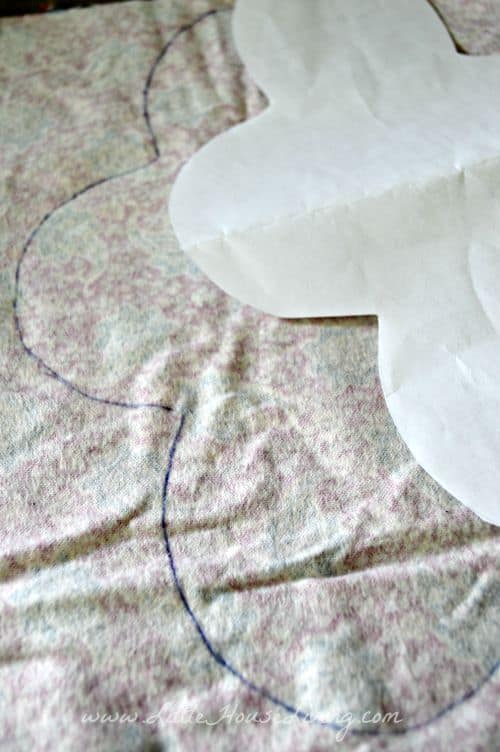
Step-By-Step Instructions for Making Reusable Pads
First, you will need to trace around your pattern on the fabric. You can use a pen or a fabric pencil or whatever you have on hand.
Cut out two of each of the patterns.
Turn the fabric inside out and sew the liner around the edges. Go around the entire thing leaving no openings. Do the same for the wings of the pad.
You can use a zigzag stitch for all of the seams but I prefer a straight stitch.
Snip a hole in one side of both the wings and the pad.
Use this to turn the fabric right side out. Do this for both wings and pad then iron each of them.
Make sure to put the sides with the holes together so you won’t be able to see them in the finished pad.
Sew the pad onto the wings.
Now for a closure…if you don’t want to invest much in the pads or you don’t plan on making many of them you can just use Velcro or a button. Otherwise, invest in a Snapper Tool and put snaps on the pad to keep it attached. (I used plastic snaps like the ones they make for homemade cloth diapers)
That’s all there is to it! It takes me only about 20 minutes from start to finish to make a pad so it’s hardly any time spent on something that will save you a lot of money!
To use the pads, simply wrap the wings around the bottom part of your underwear and snap together. It should stay in place until it needs to be changed but if you find the pad sliding a bit, add a squiggle line of hot glue to the bottom edges to help keep it in place.
Tips on Making Reusable Sanitary Pads:
The cheaper flannel that you buy the shorter life of the pad. Sometimes it’s worth spending a little more on a quality fabric so you get more use out of it. I have found plenty of great flannels in the remnants bin at fabric stores!
MAKE SURE your flannel is 100% cotton! Artificial fabrics will cause sweating.
Make sure to wash the fabric first to avoid shrinkage in the final product.
Enlarge the pattern by percentage or cut the pattern out longer for a larger pad.
You may want to add a little more seam allowance to the pattern as it did not originally have it.
How to Care for Reusable Sanitary Products
To care for your cloth pads, make sure to wash them right away after use. If you aren’t running a load of laundry right away, keep them in a small bucket (with a lid) filled with cold water and some BacOut to help prevent stains.
If you find you aren’t getting the stains out and aren’t able to soak them until the washing, at least spray them with BacOut before putting them in the washer.
Reusable pads can be washed along with your regular load of laundry. They do not need a delicate cycle.
Do not use scented laundry detergent or soap on cloth pads or it will irritate your skin.
Hang dry your cloth pads. They have a tendency to bunch when placed in the dryer.
How to Make Reusable Menstrual Pads Waterproof
- If you want the pads to be more absorbent but not necessarily waterproof, you can simply add extra layers. Just cut a few more pieces of the middle liner and add them in when you sew that part together. Adding this additional bottom layer will help with absorbancy issues while still keeping it breathable.
- Use a layer of cotton fleece inside. Again, not completely waterproof but will provide that extra absorbency that you need.
- Add a layer of PUL Fabric. This is a waterproof fabric, often used for making cloth diapers and makes a great waterproof layer.
- Add a layer of Zorb. This is a great wicking fabric that is perfect for that extra layer.
DIY Cloth Pads Pattern
If you have trouble with your monthly cycle you might also be interested in making one of these Homemade Heating Pads. They are simple to do and can be a real lifesaver!
Find more great sewing projects like this one on our Frugal DIY Projects page or head right over to this Free Printable Sewing Patterns post.
Making Reusable Pads at a Glance
What fabric do you use for reusable pads?
I always use cotton but any natural fabric such as hemp or bamboo will work as well.
Is Zorb fabric breathable?
Zorb fabric is a wicking fabric, meaning that its purpose is to draw moisture away from the skin. It’s breathable to a certain degree but maybe not as much as additional layers of cotton.
How many layers do you need for cloth pads?
If you want to make something light, one layer (or one single liner pattern) is enough. For increased absorbancy, add more layers.
What are the disadvantages of reusable cloth pads?
Cloth pads can be difficult to change when you are not at home. They can also carry an odor if they are not washed properly.
Have you ever tried homemade cloth pads? Do you think you will try making them?
Found this blog post helpful? Be sure and share it with friends on Facebook, Twitter, Instagram, Pinterest, and through Email using the sharing buttons below!

This tutorial for Homemade Cloth Pads was originally published on Little House Living in January 2013. It has been updated as of May 2023.
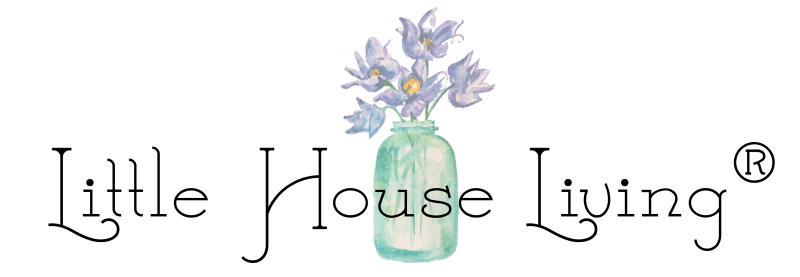
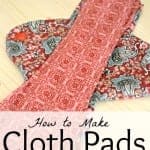
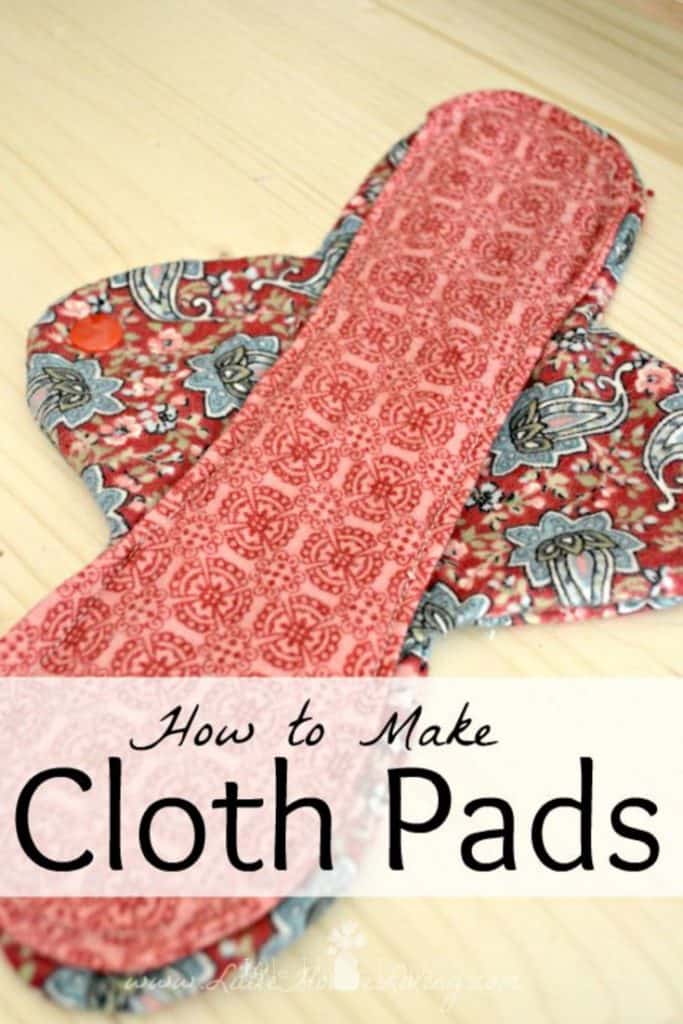
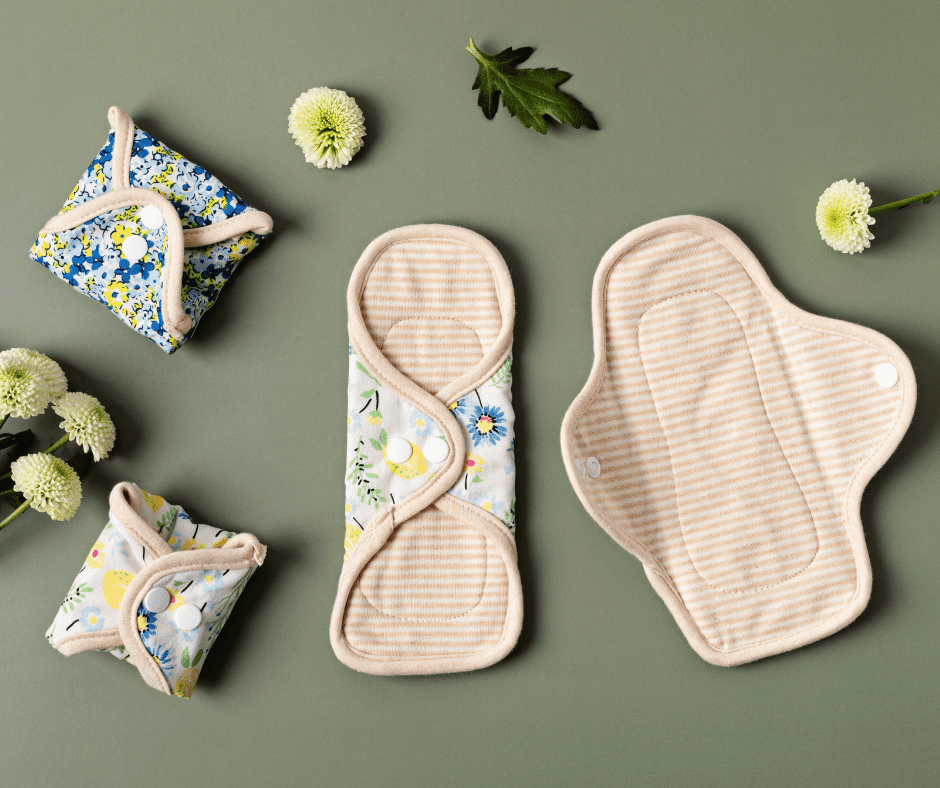
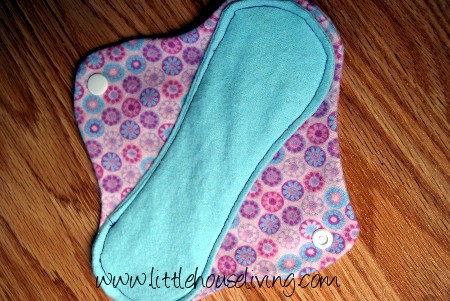
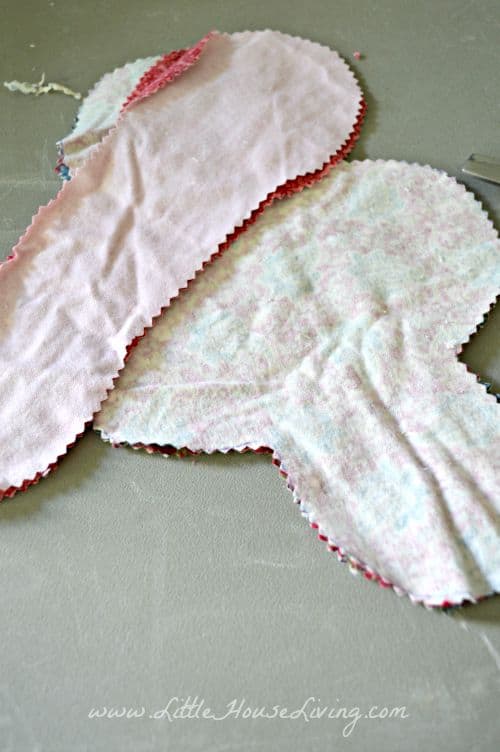
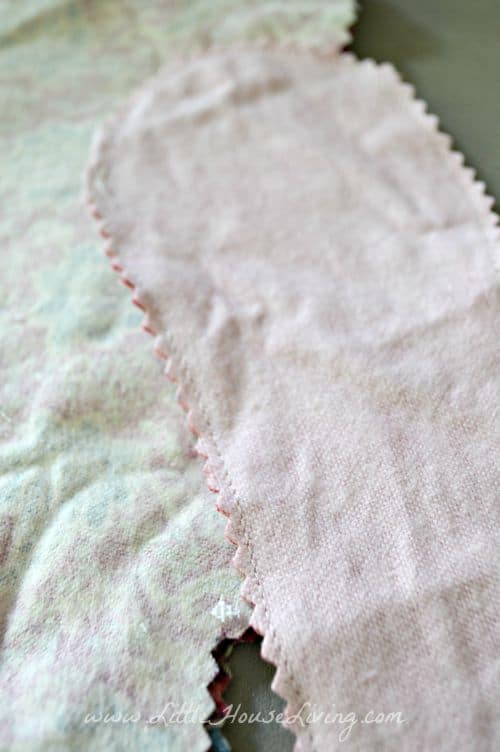
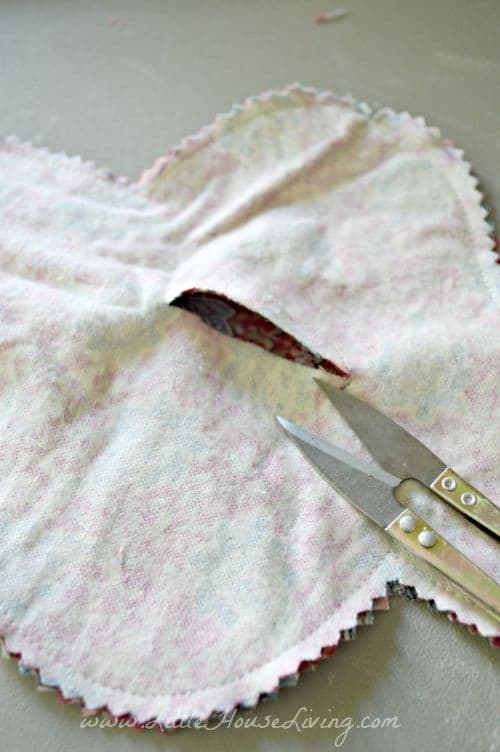
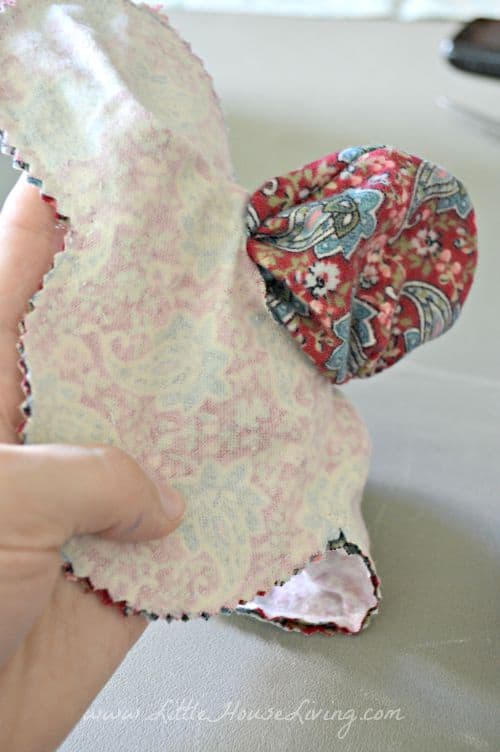
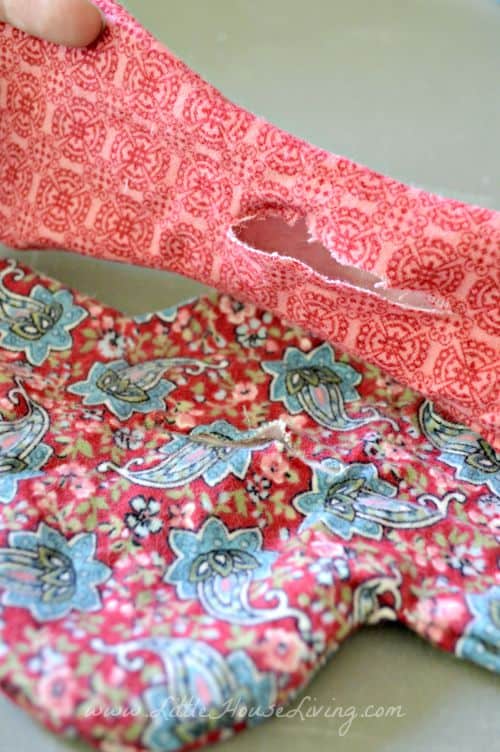
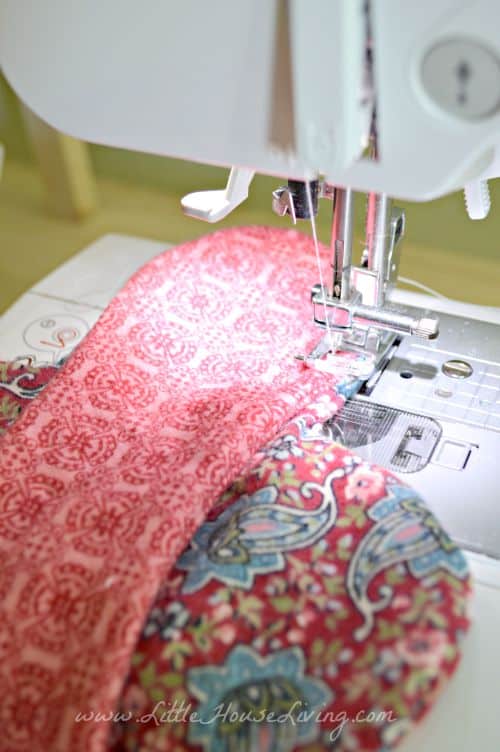
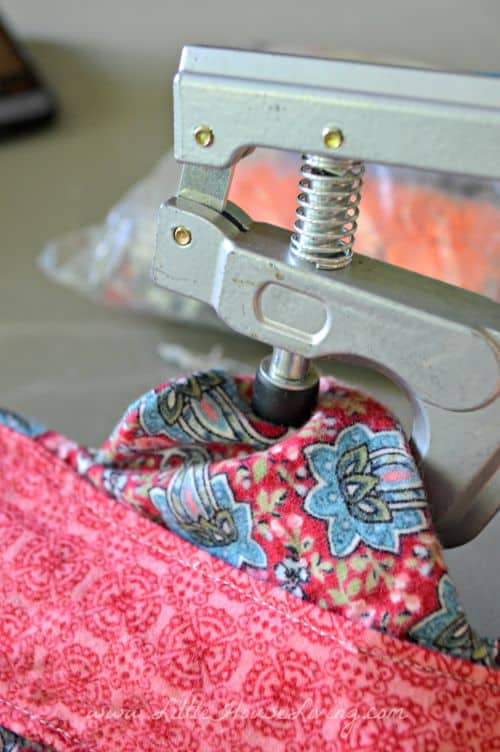
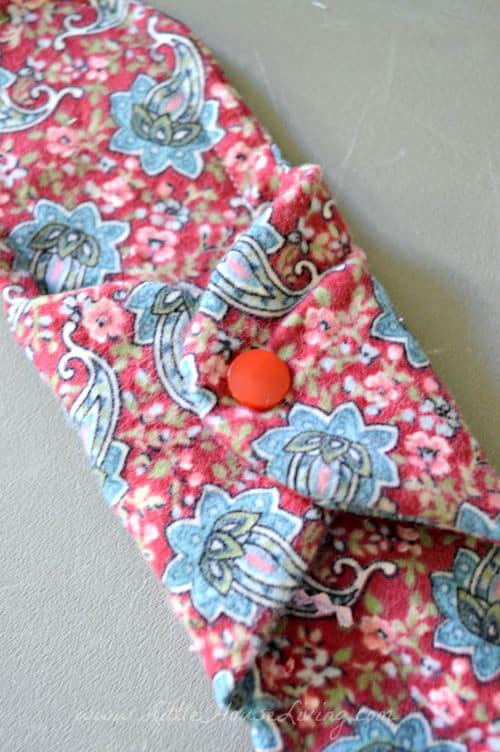
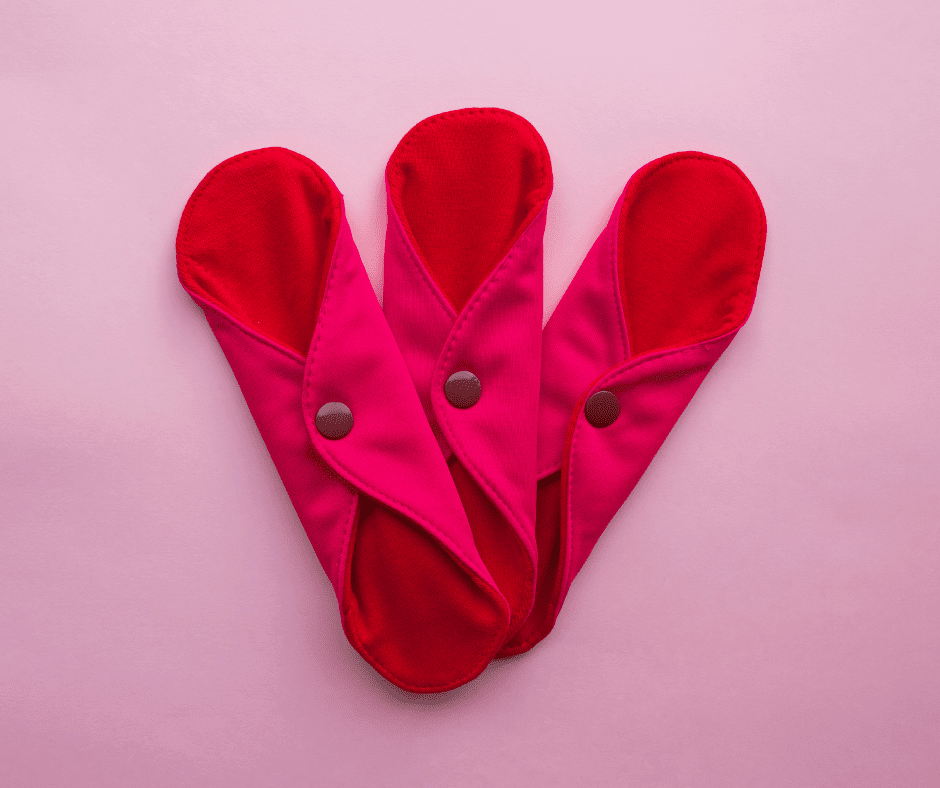
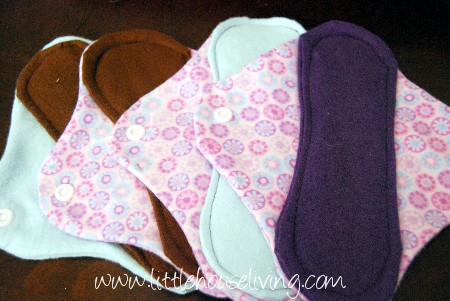
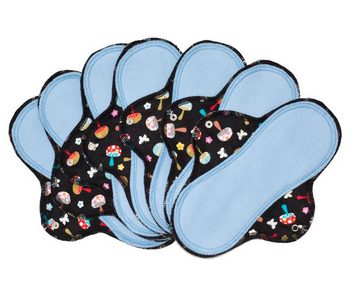
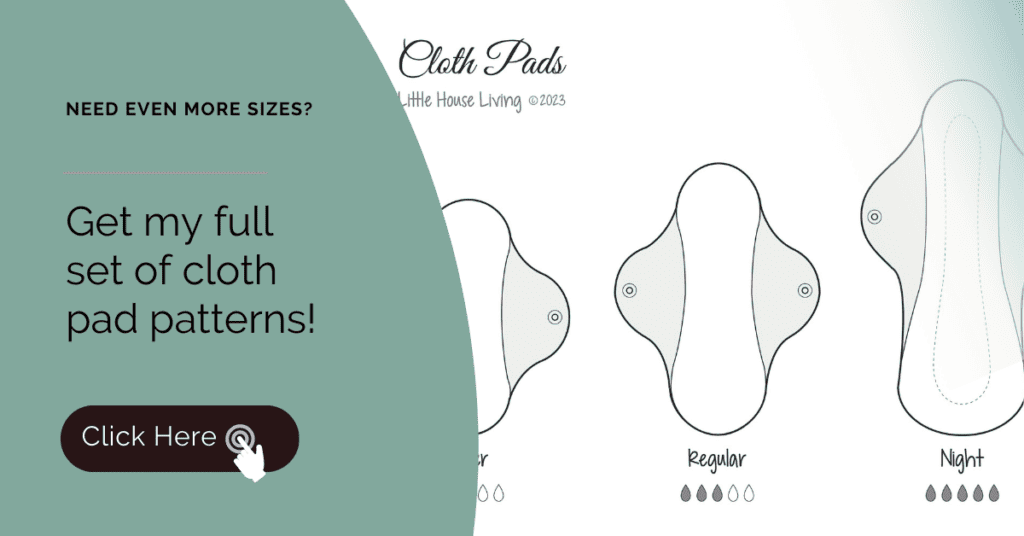

I have been using Luna Pads for a few years now. I love using them and have been wanting to make my own for a while. The Luna Pads have some sort of waterproof liner inside them that prevents leak throughs. What type of material would you recommend for an inner liner? I have really heavy periods and wouldn’t trust just four layers of flannel to hold back the flood gates… so to speak 🙂
This pattern works best for just a liner type of pad, I’ve got one I’m working on for more of a day pad. You would want to put some kind of absorbent layer plus a layer of PUL, which is the waterproof fabric that you make cloth diapers with.
I made flannel nursing pads and lined those with fleece. I don’t live in a hot area and the fleece breathed enough that things didn’t get soggy!
I would probably try a charcoal bamboo cloth diaper insert for heavy cycles. That’s what I plan in using if mine get really heavy.
Thanks for sharing. What a blessing.
How about a cloth tablecloth like you’d use on a picnic? They generally have a waterproof top.
I would think that’d be fine to use as an inside layer but the breathability might be questionable.
I think that’s called Monk cloth fabric, and it’s also made 100% cotton (although always check the label). Very absorbable and should be a good addition.
PUL is what the material is called. It’s used a lot in fabric diaper covers.
What a great tutorial. I am no longer in need of pads, but if I were, Iwould give this a try!
Mom has passed cycles as well. Now she has trouble with getting to the RR in time. I plan on making these to aid mom I. Keeping the wetness in long enough to make it to the restroom. Thanks for these ideas.
I have a bit of trouble with that as well. I think this would be a good option and doesn’t need to be thick or super absorbent.
Joining with you in this pioneering spirit, here’s my version: http://mumtopia.blogspot.co.uk/2012/09/menstruation-for-meanies.html
Your pads look lovely – better results than mine – must have another try!
A really inexpensive way to get the 100% cotton flannel (if you don’t already have an old shirt of hubby’s or a sheet that needs a new life) is to go to the thrift store and shop in their bedding section and pick a sheet that has a pattern you wouldn’t mind using for pads. They are super cheap. You might even have so much extra you would like to make some for your friends or daughter(s).
🙂
GREAT tip! Love this!
Great idea! I love my thrift shops.
The great thing about these reusable pads is is that they last a long time. Even if you use reusable items to make them, versus buying disposable items.
I appreciate you sharing this! My girls and I use cloth and believe in them so much that we’ve started selling them. I feel that no matter how someone gets started using them, it’s just important to make the change 🙂
http://www.etsy.com/shop/cozycloth?ref=si_shop
http://myworld.ebay.com/cozycloth
Thanks for showing how to make these and the reasons you should use them!
What a great tutorial and I just got a sewing machine for Christmas. I’ll have to give this a try 🙂
I’ve ordered some on Etsy to try. I also ordered the sample pack from Telulah Bean. I loved those pads! I was skeptical about trying them. Awhile back my husband told me I should be using them. I thought gross! I have to say that I love my cloth pads!! It really isn’t gross. I have started making my own as well. I will be starting to make the post-partum ones; I’m due in June. I have recommended them to my friend and her daughter. They like them as well. So much more comfortable than plastic!!!
I have been using some off of esty for years 🙂 I am extremely allergic to any type of commercial store-bought pads, tamponds, panty liner ,etc. I get a bad rash that spreads down my legs that is painful and itchy. I delt with it for 3 years before I found cloth pads. I was desperate because my skin literally looked liked it was peeling off in chunks. As soon as I switched I have never had any problem at all!!!!!!!:) thanks for the great tutorial . This looks like the easiest one i have so far . I have made some before but I use zorb between the flannel layers. It’s extremely absorbent and I never leak with it. You have to be careful with the lined pads because they are normally lined with pul and that can cause yeast infections because of decreases air flow:)
Hi Kelsye,
May I ask where you get zorb, and what kind of price point does it sell for? Have heard of this, but I think it’s synthetic, so want to look into it more, but didn’t even know where to find it if I went with this layer.
PS Merissa,
This is really nice! THANK you for posting this tutorial and pattern. I hadn’t considered making it until seeing yours with the pictures of the steps… I feel like I could manage trying it! Really appreciate this. Just learned of cloth pads yesterday and have been scouring the internet trying to find free samples (have only come up with paying for 3.99 shipping + $2 to upgrade to organic for one at party in my pants, 5.95 (but no organic option) at gladrags, and looking at some options on etsy that were cheaper like $4 plus shipping (just sort by price).
If anyone knows of other companies that sample or freebie organic ones at a decent price can you reply and lmk please?
And if anyone has suggestions on places to find new organic cotton or cotton flannel on a budget, I would love the leads. I like the idea of looking at scrap bins at fabric stores… don’t even know if they would have organic options though…
Thank you all
Joanns always has sales going on.
what’s Zorb?
its a cloth that helps absorb, check wazooble.
I had the same problem with dispensable pads all my life (even back to diapers) so I switches 18 years ago when I found cloth diaper incerts were a thing. That plus the diva cup saved me thousands of dollars and pain. Now all these cute patters come out and I don’t need them any more. I would suggest bamboo fabric, held up great for 18 years.
Oh my gosh – this is so crazy! I was just yesterday putting my first effort into making my own pads, but I was having problems making my own pattern! I was using this tutorial — http://www.tinybirdsorganics.com/organiccotton/clothpads.html — that used terry (towels) as the pad layer, and as I was cutting them, they shedded over everything!! I am really going to try yours. Thanks so much!
Let me know how it turns out for you!
I no longer have periods, but when I did, I loved using the flannel “Glad Rags” pads; it was so much more comfortable, even though I had ready access to free pads by using coupons. Things to remember are: you want to initially rinse the pads out in COLD water, not hot. Cold water gets out the blood, but hot water sets it in. Also, after rinsing, pour hydrogen peroxide on it and let sit for a while. After that, I’d usually rinse again before adding to my regular wash. And I usually use hot water to wash my clothes despite the usual advice of using only warm or cold; I like to try to kill some germs, too, while washing clothes.
Anyway, if I’d a pattern and directions, I would have liked to make my own pads, and I love Andrea’s idea of buying something flannel at a thrift store! Most new fabric has chemicals in it, such as formaldehyde, in it, so better to get a fabric that has been through the wash before, and then wash it again since you don’t know the history of that particular flannel.
Great tips, thanks for sharing!
Thanks for the information. I wondered how you would properly clean the cloth pads.
So glad you shared. What do women think their ancestors did before disposable anything? My mom learned how to make “rags” from her grandmother. I am only 48 folks so that is not too long ago. Not a bad idea to at least talk to younger women about these options as “disposable pads” might be scarce in an emergency.
Just started sewing my own because I can’t affored to buy them and I can’t wait to try them out I use 4 layers of terry in the center because Zorb is to expensive and the water proof fabric is PUL and I also use quilters cotton for botton or top but I like the minkey top a little better but e/w urs look awsome thanx for sharing 🙂
I was wondering where you buy your terry?
I’m thinking about sewing these to put into an Operation Christmas child box, they need to last and not leak, but be economical to make as well.
I have been making pads for shoeboxes for about 3 years now. They are so grateful to get them. I use the pattern from little dresses for Africa. Their dignity project. We add panties and safety pins. I have also used the pattern from the patchama project. Most fabrics I use are flannel, toweling and fleece. And some cotton. None have asked for any waterproof backing.
Great post, Merissa! I’ve been wanting to make my own pads for a while, but I use tampons, so I’d only use these at night.
Tammy, I would love to endorse your idea of putting them in shoe boxes, but unless you know the boxes are going somewhere they have access to washing facilities, I would be dubious about doing it.
The shoebox reciptients are very happy to get them. I have been making them for 3 years now. These girls/ women have no money to buy and most times are not even available if they could afford them. These girls are missing school because of not having “supplies”. Please do send them. They ewill be much appreciated.
Where did you get your snap tool? That looks like it might be a good purchase.
I got mine from Hobby Lobby. I noticed you can also get the same one on Amazon for a little cheaper…. http://amzn.to/X7NZ8H
Why not try using wool as the inner fabric for more absorption, of coarse flannel as the outer fabric….preshrunk wool…of course
Yes, wool would work.
Try fleece
How about adding a layer (or 2) of microfleece inside for extra protection? Good idea or bad?
That’s the same idea behind a color diaper so it might work. You would want to add in a layer or PUL (waterproof) fabric though as the microfiber would wick away the liquids and you wouldn’t want it to leak.
where would you get the PUL and what is it if i may ask..my church women’s group will be making some of these to be sent to girls in very poor countries so they may stay in school and not miss so many days..
PUL fabric can be found at most fabric stores, I’ve even seen it at hobby lobby near the cloth diaper fabrics. PUL is a waterproof, laminated fabric that will provide a perfect moisture barrier (which is why you find it by the cloth diaper sewing things!).
I’ve gotten mine off of Etsy, but it would be fun to make them. For the ladies that like their tampons, have you tried a menstrual cup as a non-disposable option? (no TSS worry). I saw that they’re mentioned on this site. LOVE mine (I use a Lady cup, which I like better than my Diva cup), and the thinner cloth pads work great as a backup. I wish I’d known about these alternatives sooner, so thanks for getting the info out!
I use homemade cloth pads in conjunction with a diva cup. I had TSS twice when I was younger and trying to use tampons. I have had no issues with the Diva cup or the cloth pads.
Anti pill fleece works good as a backer to keep it from leaking through. It is less “slippy” and more breathable than PUL, although it is a little bit thicker. It’s what I use, and it works great for me.
Hey Merissa,
How much fabric do you use per pad? I want to buy enough fabric for 92 girls to be able to make their own pad at an all girls sleep away camp this summer! Trying to figure out how much fabric to order (i.e. how many yards).
Any help with this would be appreciated! Thanks.
Good question….I’m not sure I guess, I would say that 1/2 yard of flannel should make around 4 pads. It could be more though. Sounds like a fun project!
Thanks! I think the girls will love it :).
Thanks for sharing your pattern! I’ve been using cloth pads made by a company local to me (back when I lived in Halifax) for the last several years and yesterday made my own out of some scrap, although, it didn’t occur to me to use flannel for the whole thing! That WOULD be comfy! I used a mix of flannel and terry cloth ^^
Willow Pads. Ok product. TERRIBLE customer service. I do not recommend this company. I purchased my first, ever, supply of organic pads from Willow Pads. I wore them once and washed them once. One of the pads’ stitching had missed the material and it came loose in the wash. I called them and had to leave a voice mail. 4 days later, I emailed them. Next day, I emailed, again, with a picture of the faulty pad. That was a week ago; still not response.
I haven’t heard of this brand but thanks for letting us know! I will be staying away!
I would love to try cloth, but since having my youngest and having a tubal during the c-section, I have had horribly heavy periods. For the first two days I have to change a super tampon and liner every hour, or a pad AND tampon every two and a half hours when I teach. I cant even wear JUST a pad during those first two days otherwise a simple move, laugh, sneeze, cough causes a major gush…its bad.
Zene, I had the exact same problem…talk to your ob/gyn about having an endometrial ablation done. NO woman should have to suffer like that, and since you’re finished having babies, an ablation is a good option. I had mine done 5 years ago, and I wish I’d known about it right after my tubal…I spent SOOO many years suffering!!! Best of luck to you!!!
My mom was born in the 1920’s she use old sheets because the store bought type hadn’t been invented yet. When I was growing up we didn’t have much money so that is what she gave me to wear to school. She always said it’s better for the stuff to drain outside of our bodies. I think she was smart about that. Thanks for sharing this sewing tutorial about homemade pads.
Anyone ever use Procare waterproof fabric?
I’m not sure if it’s the same but I’ve used PLU which is waterproof. It makes a great extra layer in the pads to make sure nothing gets through.
I am also past that stage but now have a little urine problem when I cough. Would this pad hold up for that. Urine is more liquidy than blood. Would I need it thicker. What is pul? You amaze me on how frugal and down to earth you are. God is using you to teach many . He always leads me to people to show me how to make the best of resources which I have not done. Again I am thankful He lead my finger to pick your site. IN the winter I do a lot of sitting at the sewing machine so will the snap bother me. Older people’s muscle tone is more tender . Velcro sound good but would not last in machine unless maybe if left velcroed
PUL is a special kind of waterproof fabric, if you ask for it at your local fabric store they should be able to point you in the right direction or it can be found near the cloth diaper making supplies.
Polyester PUL can be bought at Joann’s Fabric store. You can Buy it on line from a lot of places like fabric.com, both have every thing you need including Minky fabric the best (in my opinion) for top layer is 2 to 3 millimeters thick. You can get Cotton PUL from kidsinthegarden.com(great company,not mine, just my opinion).I made my own 8 years ago, now I am in menopause and I still wear them for incontinence. I still have all of the ones I made. I make new ones every once in a while and have introduced others.I also make custom bras and undies.
Merissa, yours is one of the easiest tutorials I’ve seen!!! Thanks so much for sharing!!! I’m up to my eyebrows in canning still, but these pads are going on the top of my “to-do” sewing list for winter!!!
Loved this tutorial Marissa!! You made it so easy to follow!
I just recently started making and selling Modern Lady Cloth too.
Very excited about cloth.. i must say 🙂
Check out my Facebook Page @prettyecointimates.
Thank you so much for sharing this information! I find that my pad always slips up my behind and barely catches anything in the front. I found this to be true with the GladRag brand and my homemade ones. Do other women have this problem or perhaps I just need to make them longer on one side? Also, what’s everyone’s secret to keeping your pads out of view from people while they are drying and waiting to be washed? It’s hard to hide them discreetly without putting them in a closed environment where they won’t dry or smell. Afterall, no one wants to see a 3 year old stained pad hanging from a shower curtain when visiting your home. I also want to mention that I use the Keeper which I have had great success with.
I recommend getting a little wet bag (like for cloth diapers) to hold them in until you wash. I just toss the whole bag in the washer too. I think you might want to make them long on one side if you are having that issue, it might work!
Holly, I have the same problem as you with the pad “moving”. I just wanted something like the really light pads that you wear daily for the times you sneeze or cough and almost pee yourself, but they just won’t stay put! My sister pins hers in place, but then it tears the underware. I would love to hear any solutions anyone has to give me.
I know you asked a while ago, but I’ve used a fleece layer as the bottom layer, and it has more “grip” than flannel, and moves around less. But yes, make them longer so that even if it shifts, you still have some protection!
Just a thought as I have never made these myself but I would try a gripping strip like you would put on the bottom of a sock or maybe a rug. Another option would be those gripping squares you can get at the dollar store for opening jars though I’m not sure how it would hold up to washing.
You could also do a little hot glue or “puffy paint” on the underside to help it from sliding.
Someone mentioned earlier to put a strip of hot glue on the bottom of the pad. It is a good non-slip product. Easy fix!
Everywhere I read says you have to put a waterproof pul fabric backing or they will leak. I really want to use organic fabrics and that clearly is not, any suggestions?
I haven’t had any issues with the cotton flannel I use but those pads are more for light days. I’m not sure what a good organic alternative would be for PUL besides maybe adding extra layers?
Kristine-
I have several different pad sizes for various flow levels. For really heavy flows I use 6-8 layers of flannel and many times use the keeper (like a diva cup) for extra protection at night or when I’m in public.
Holly
@Kristine
I’m with you! I would prefer not to use PUL fabric and would also love to not feel like I have a log between my legs because of the layers. I was looking into using Zorb, and I feel more comfortable with that. Supposedly “Zorb contains only tangled cellulose fibers from bamboo/cotton/viscose and poly micro fiber”…not perfect, but it seems a little better? I think I will try it.
If anyone else figures anything else that might work as a filler that is super absorbent, please share!!
I’m definitely interested in knowing about an organic waterproof option as well. Have heard 2 layers of organic flannel might work well, and Party In My Pants uses some unnamed “nylon leak-resistant shield”.
Hi, I’m fairly new here, but I wanted to comment. I get my pads from New Moon Pads in Canada. She uses Malden Mills Sherpa Fleece as her waterproof layer. I understand it is rather expensive and I don’t know if it is environmentally better than PUL. What I can tell you is that it is breathable and it works. Water just pills up and rolls off. When I’m rinsing out my pads water doesn’t go through it until I squeeze it out and it is dry to the touch immediately. I have a fairly heavy, gushy flow and I haven’t had a leakage problem yet. Hope this helps.
I know this comment is really old but I wanted to reply anyways for others who are just finding this site (like me): wool is water-resistant and may be water proof enough for this purpose. I had some wool covers for cloth diapers for my baby: the wool was very thin but did a good job of containing the pee. I would recommend a separate wool layer as it needs to be washed and dried differently and re-lanolinized every now and then to retain it’s water resistance. Look for light-weight wool or possibly some of the thinner worsted wool which is usually meant for coats or pants. These should be available in organic options.
Thanks for posting. I’ve been using cloth for several years now, and I will never go back! Just the comfort of cloth is worth it if nothing else!
I make my own very simply; just a circle of 2-3 layers flannel (from old sheets), sometimes with some old towel in the middle. Zig zag stitch around the edge, and put a snap on either side. Easy peasy!
For those wondering about heavier days, I often just double up on the cloths. With mine I can roll one up and slide it between my undies and another cloth to create an insert layer. For night time, I use two; one a little to the front, and one a little to the back so they overlap in the middle for extra protection. I doubt this would be enough though for the lady with super heavy flow. Sorry to hear! Good luck!
They do leak through to my undies sometimes, which isn’t great, but it’s better than infections, so I leave out the waterproof layer. If you wanted a more eco friendly version, maybe the water-proof breathable shell layer from an old jacket would work?
I should have wrote about PUL not causing infections or that it is not breathable.PUL is used in cloth diapers it does not cause Yeast infections it is breathable I have worn a cloth pad every day for the last 8 years. Wished to god I had known about them years before.
Store pads are no longer in our budget and since I realize I will have urine leakage (in small amts) the rest of my life, this looks like a realistic alternative! Thank you for the ideas and advice, they make this project so much easier. I am shopping for fabrics tomorrow!
I’m new to all this, so my first question is – how well does the blood wash off? :/
It actually washes off really well. If you are worried about it you can always either use a stain spray (I use Bac Out by BioKleen) before washing or you can place in a small container with a bit of water and baking soda after use until you can wash.
I have never had a pad stain ever,but I don’t use flannel on my top layer I use bamboo or minky. works great!!! Rinse in cold water in bucket with a little oxygen cleaner (I use LA’s AWESOME from Dollar Tree)wash in hot water with home made laundry soap or small amount of tide rinse with Vinegar in last rinse Dry No softener. No static no smell no stains no soap residue.
Thanks for sharing this great pattern. I’ve used Gladrags which I like but too expensive for me. I’ve got some cloth pads from Momscrafts4u on Etsy. <which I wear when I'm away from home. They are leakproof and awesome!
But I was thinking of sewing my own to wear when I'm home and can change more often. Your pattern seems easy enough for a beginner like me! I made the switch to cloth about 15 years ago and haven't looked back. Less bleeding, less cramping, etc… Not to mention the savings. Thanks again. Love your blog!
Thanks for this pattern!! I am looking into making my own because I use disposable pads and they are absolutely horrible. It stinks and I get a rash from it so I will be switching to cloth in the very near future. I have never been a fan of tampons either. I will take a shot at making this because I want to save money, not produce as much waste, and be healthier because of it. I’m 17 years old and all of the res of my family thinks it is gross but I absolutely love the idea! I wish I would have heard of it sooner! Thanks again!
I’ve been using WeMoon pads and love them! My cycles have reduced from 7 day agonies to 3 days without the need for any pain relief. The waterproof liner is a must though!
I soak the used pads overnight and use that to fertilise the garden – how’s that for organic and sustainable :o)
What if you put a shammie fabric in the middle? You know the kind you use to dry your car? They are supper absorbent and they sell them at the dollar store.
Yes, you can do that to make a heavier pad. 🙂
Just wanted to tell you I finally got around to making some pads. I made some with 4-6 layers for the middle part and found if I cut the slit in each one before sewing, it made it much easier than trying to cut through all layers after it was sewn down.
They work great!
This is a technical question. Is the line on the pattern the cutting line or the sewing line? Do I need to add seam allowance to the pattern or cut as shown.
Thanks! (I’m making these for my daughter)
It’s the cutting line. You can add a seam allowance if you want a little more space to sew.
How do you know if fleece is anti-pill, or no- pill? I have some fleece and flannel sitting around that I’d like to try making pads with. I’m pretty sure the flannel came from Walmart though… it’s probably not cotton huh?
Hmmm, good question. I’ve bought quite a bit of cotton flannel from Walmart since we don’t have many other stores here and it’s worked well for these.
If anyone is wondering if their fabric is cotton or not, try burning it a little bit. cotton will smell nice and smoky and get crispy and crumble easily. Synthetic fabrics will smell pretty bad and will be more hard on the edges.
I think I will be trying these. This is great I can alter to my daughter and I’s needs. Thanks for sharing!
Hi! I know this is an older post, but I found it on Pinterest and wanted to comment. I made up a pattern myself last year (way not pretty lol) and made around 8 pads. I have a super heavy flow, so I use tampons on the heavy days with the pads for backup/leaks and these alone for lighter days. I made mine solely out of recycled fabric, old baby blankets and flannel shirts from the thrift store. It was very cheap and I love them to death, so much money saved!!! Thank you for an actual pattern I can follow! I’m down to 4 (from my very beginner sewing skills, some have since fallen apart!), and need to make some more. I’m also thinking of making some up for Christmas gifts for close friends! 🙂
Just wanted to say thank you for the pattern and tutorial. Everyone wants to sell these and I really can’t understand why. If I couldn’t find one I was just going to trace one of mine and use 1/4 inch seem allowance. This will be much easier.
No problem Angela 🙂
This is a great tutorial and I see it got a lot of shares!! I wish you’d update the directions with the following hints though, from a long time cloth pad user. Stuff the pad itself with a layer of warm-n-white. Use pure polyester thread to sew these to prevent wicking. Hide a layer of PUL in between the flannel layers of the wing section, to make it fairly waterproof.
I’m interested in making cloth liners… it feels like I am having a reaction to the disposables. :/ I got a FFS liner from GladRags and I love it. My question, though, does it need to be a particular flannel? I have old flannel receiving blankets that no long will get used, do you think those will do alright for homemade liners?
Thanks. 🙂
I would just make sure that it’s cotton flannel so you know that it will be more “breathable”.
I would like to know if other ladies cycle shortened, as did mine after I made the switch to cloth 3 years ago. After the first 3 months of wearing cloth pads, my period went from 7 days to 3 days and has stayed that way since. I mentioned this to my doctor, who of course, has never heard of cloth pads and didn’t seem to give a care of what I was talking about, and said no such thing can occur. She said it must have been a hormonal change in my life. I disagree with my doctor completely.
I haven’t tried cloth yet, but I’ve read a lot of reviews in the last 2 days and many people and sites say this is a positive result from switching from disposables with the chemicals/bleach to cloth. So I figured I’d let you know since no one has replied to your comment on here yet. 🙂
My period has gone from 5 days with 2 heavy days to 4 to 4 1/2 days with only 1 heavy day. I am using a cup (Sckoon cup, but just ordered the Super Jennie) with cloth pads as back up. I am on my 4th cycle of this. My reasoning for ditching the disposables was a year of battling reoccuring vaginal infections. I haven’t had 1 infection since switching. I also did work on my diet and changed up the probiotics I took to those for vaginal health. So far so good.
I had to wear the largest pads that you could get (Always).I would put them end to end with the center over lapped.Leaking at night was always a problem. I was put on birth control by a male Dr. he didn’t think having blood clots that was as big as my hand was a big deal so on the pills I had my period the whole time(the clots looked like strings about 6 to 10 inches) I stopped taking them. I saw a thing on you.tube and I could not wait to try them I went to Joann’s and Walmart and bought every thing they had and started making pads. Yes that happened to me I had 2 periods a month for about the last 12 to 15 years I used the first time and my periods went down to one period then that got lighter then less cramping then just before I started real menopause my period disappeared for the months of April to June then it did it again in August to December then no periods at all and I wish I had known about them before.
Hi Merissa,
I was searching for something for my daugther with downsyndroom.
She hates the normal cloths and last summer she had her period on our vacation. I’ve made her something of an old towel and a skinny short so she could swim too. She loved it so much that I want to make those cloths for her periods.
I just found this;
http://www.diapersewingsupplies.com/what-is-pul-fabric-pul-fabric-by-eco-pul/
I’ve just ordered this in a dutchwebstore. Can’t wait to make them with your tuturial.
Kind regards,
Brenda.
I really hope they work for her Brenda. 🙂
My search for zero waste alternatives led me to this site. And then I decided to give it a try. The reviews were also encouraging and the steps were the most simple of all I saw for making cloth pads. Today I am using my first cloth pad and I can’t keep from smiling, it feels good😊. Wish I could post you a picture. Thank you for the tutorial.
I like the style of these pads. I’ve been making my own cloth pads for a year now and have a stash of about 30. I have made several patterns and still haven’t found the one that I like best. I will have to give this one a try. However where you cut your fabric there is only two layers of absorbency. It would be alright if you are a light person. But I would be scared to use them. If you left a small opening of about two inches on a flat portion of the seam between your layers then you could just flip it there and sew that closed. That’s what I do. It would take less time and insure less leakages. 🙂
Please send pattern for pads
How would you make these for an older woman who has incontinence?
Marissa,
I agree with a commenter (Ashley-10-27-15)…
…There really should be an update to directions. . .
It would be much better to leave a small opening on a longer / flat side for turning the fabric. . . then once turned right side out, press it, tucking in the seam of the opening…
When making these with several layers, you could stack the (inner) pads together before sewing to the outter.
In my opinion, cutting the fabric (in the middle), would just compromise the ability of the fabric to have a stable liner… it would eventually separate or open in the center, leaving less space for absorption. . . .
I know the directions were made to be simple, but for simplicity and a better absorbing nature, , it would be more practical to make a cut at one end or the other… just not in the center, where the thickness is needed.
I have a friend who made these years ago who used diaper flannel dyed a really dark color so they didn’t look icky when they were clean (no stains). She also used diaper changing pad, left over from having little ones, for the moisture barrier. Thanks for the pattern, great picture instructions and tips.
I forgot to mention that she used some type of hemp fleece( may have been a combo of hemp and cotton) fabric as the absorbent layers. The Hemp is supposed to be more absorbent than plain cotton for the same weight. When I make mine, I am going to try to create a way to make the thickness adjustable/removable.
Thanks for the thrifty ideas. I have several diaper changing pads not in use right now. I was going to just donate them, but reusing them will be better!
I would love to make these, but do not own a sewing machine. I would have to learn to hand sew them. How are would it be to hand sew the pads? Any help is appreciated.
Since they are a small project I don’t think it would be difficult at all to hand sew them.
Have you seen any patterns for homemade incontinence pads?
Thanks!
Hi!
Thank you for this tutorial. I just tried making a few cloth pads the other day, but your tutorial looks way easier! And way cuter!
Question:
Does your pattern already have seam allowance added to it? Or do I need to add it myself?
Thank you!
It needs to have a seam allowance added to it.
This is so creative! I’ve heard about cloth pads and have been very interested in them. I like the fact that you just made them yourself. Very impressed! lol! Thanks for sharing at the Wonderful Wednesday Blog Hop 🙂
I don’t sew, but I’ve definitely been considering buy some cloth pads for my lighter days. Pinning to share! Hollie
Great project! I’d love it if you shared this on the brand new DIY party!
Hi Merissa. Your Homemade Cloth Pads are so adorable and useful too! Congratulations, it was the most viewed link at last week’s Creative Muster Party and will be featured tomorrow night! It’s also been shared on all of our social medias for our followers to enjoy too. Hope to see you tomorrow night at 6pm. ~Heather
I just found your website and fell in love. You had me at the lessons from the little house books. I loved those too as a girl. I had just resigned myself to shelling out big bucks to the party in my pants folks. I was looking for a more eco-friendly alternative for my tomboy daughter who will be starting menstruation soon. So I printed out the cloth pads patterns, reduced it by 75% to make them smaller. I left a small opening unstitched in order to turn the pieces right side out instead of cutting a slit. Then when you top stitch the wings and attach the liner to the wings you can sew this opening as well. I finished seven of the smaller size in some cotton fabric left over from some quilting projects for both of us to use as liners. I even had snaps, so the total project cost me nothing. I thought it would be a hard sell to get her to use them, but my daughter loved them! Thanks so much!
Awesome, I’m so glad they are working out well for her! (And welcome to Little House Living! 🙂 )
Hi Merissa! You know, I heard about making your pads years ago and it was something I always thought of trying but your posts might’ve just given me the motivation to try. It makes so much sense. Thank you so much for sharing at Thriving on Thursdays last week. I’m featuring this post at tomorrow’s party. Thanks again for coming.
Anne @ Domesblissity xx
I hope you do give it a try. And thank you for the feature!
Absolutely love this pattern! After scouring the web this is the one I went back to and I’m so glad I did. To make the pad a little thicker I sewed a layer of pul and thin towelling to the wrong side of one of the winged pieces before I started then followed your instructions to sew it all together. I must confess making these has become an addiction! I love how they look and feel, they are so quick to make. I have made 15 so far all in different colours from my stash and will make more because I can’t help myself! Great pattern thank you so much!!!!
Thank for this tutoriel. Il will try it because i’m allergic. …
I love these patterns, and ease of the pattern. Wuestion, I mo longer need these for menstrual needs. However, I do need them for bladder issues. What would I need to add for that?
I am an older woman with incontinence , specially at night when I wake to go pee. Is there a way to make these like the overnight pads I’ve been buying….I sure could use the saved money as I’m on a fixed income. Thanks for any suggestions. Marie
For a water resistant layer i’m using:
a waterproof mattress protection bed sheet for kids. It has a cotton terry top and a liquid proof coating at the other side. From a one-person sheet you can make a lot of liners! 🙂
On top i use an extra flannel layer.
(Also great for urinary incontinence liners. For women and man too).
Good luck to everyone!
hey i was just wondering about the pads pictured? they ook really awesome but a little longer? do you also have a pattern for them?
I just used the original pattern and extended the middle of each piece to make them longer 🙂
I am getting ready to make my first mama cloths, I haven’t tried them before, but I am due in March with my second and I want some postpartum pads. I think this pattern is gorgeous and would love to use it! Do you have a postpartum version? Am I just missing it somewhere? Thanks for sharing!
As of right now this is the only version that I’ve made. You can add extra thickness by adding another layer of cotton (or two or three) into the middle or some commenters have added in a layer of PUL. I’ve also made it longer by just extending the pattern as I’m tracing it onto the fabric.
Hey Jessica,
I am having 2nd in 5 weeks now and just made some post-partum with Merissa’s design (and hopefully they work!).
After turning the middle pad inside out I stuck in the middle part of a prefold and then sewed two lines down the middle, to direct the blood flow, as well as too keep the absorbent layers in place.
I also changed up fabrics and made it longer.
I have a problem with incontinence and the plastic on the store bought pads leave me with the worst case of diaper rash you can imagine. I happened to spot these and am going to try them for my problem.
This post saved me from having to use disposable! A little back story. I ordered pads three months ago and well long story short they had to be re mailed. But mother nature surprised me yesterday and i found your post and went to walmart!
Im allergic to most fenimim products on the market today. Including pads and tampons i have to special order shampoo and conditioner etc. Or i break out in a lovely rash.
So thank you for your post. I shall look more into your posts.
I don’t know if anybody else got this tip out there or not, but here’s an extra something to check for when choosing your flannel: be sure and water test it before you dive into making your pads. I picked a flannel that I thought would work well and had my first cloth pad all sewn up and waiting to be tried out and didn’t even think to test its absorbency. I still might not have tested it if my nephew hadn’t dripped water from his sippie cup on the floor. I grabbed a scrap of the flannel as the closest thing around to mop the water up with and found to my dismay that it only absorbed some of the water and smeared the rest around on the floor. NOT reassuring! But I thought perhaps the flannel scrap just wasn’t big enough for the amount of water, so I took my finished pad to the sink and turned the faucet on to a slow drip. Sure enough, when I placed the pad under the water it beaded and then slowly absorbed. I don’t know if this problem could maybe be fixed by washing the flannel a few time before using it or not, but I’m definitely going to make sure that my flannel absorbs efficiently before I sew up any more pads. 🙂
Interesting…do you know what kind of fabric the flannel was made from? I’ve only used 100% cotton flannel.
No, I don’t know what kind it was, it’s was just a random scrap we had. I thought it’d work good because it felt substantial without feeling really thick and hot (some of the flannels we have felt thin, some sweltering. But I may have to re-adjust my priorities to absorbent first, thickness after:)). But my Mom said the flannel I’d used didn’t absorb well because of the fireblock they put on them now-a-days. Do you know of anybody who makes them without the fireblock anymore? 🙁
I may just have to be sure and use an old enough flannel, like the old pajamas that a lot of ladies say they used, and not buy any newly manufactured flannels.
So are there different kinds of flannel? I had thought flannel was kinda universally cotton, like denim for the most part is. 🙂
I think you can look for the fabrics that say “not suitable for children’s pajamas” because I’m pretty sure they have to put the flame retardant fabric for pjs.
I think most flannel is cotton but there is a large amount that is polyester or a cotton/poly blend as well.
Ah, got it. 🙂 Thank you so much!!! Now I have a few pointers to go on if I end up having to buy new flannel. 😀
So I’m having trouble getting the pads to come clean:(. The first one I rinsed in cold water and then soaked overnight in a equal parts vinegar and water solution and then threw it in with a load of towels to wash. It came out “clean”, but with a slight metallic smell. The second time I added tea tree oil to the soak, and soaked one pad for a day and the second one overnight, then added a detergent booster to the wash. They came out a little better, but they still both have a slight metallic smell to them. Mama says try baking soda in the soak next, but if that doesn’t work we’re pretty much fresh out of ideas. Any suggestions?
Hi, I’m two years late to your comment but for the sake of others reading here, I have an idea. Try the baking soda and vinegar, of course, but if that doesn’t work, you could go to the pet store and buy some enzymatic cleaner that they sell for getting pet odors out of carpets, furniture, bedding, etc. The enzymatic cleaner breaks down the proteins that are lingering and causing the odors. I have a feeling that this will solve your problem!
Vinegar sets things into fabric when soaked (it’s how we set tie dye fabrics). Just cold water alone should get most the mess out. A dab of dawn dish soap, or a capful of peroxide per gallon of cold water would help prevent stains from setting in.
The enzymatic cleaner will definitely work to remove smells. I use enzymatic cleaner to remove cat pee smells from floors and furniture and it is the ONLY thing that works 100%.
It’s 4 years later😉, but after a lot of digging online and experimenting I’ve finally found a simple, inexpensive, nearly foolproof cleaning method (I say nearly because I did manage to fool the proof by piling them in a bucket and forgetting about them for a month until they molded😳) using hydrogen peroxide and witch hazel. I’ve given up completely on the bucket soaking method. Living in the South means change the water EVERY day or things will… well, go South🙄.
So now at the end of each day (sometimes I miss a day, but since the mold thing I’m more careful to tend to them promptly) I collect the used pads from that day and rinse thoroughly in cold water, then I squirt enough hydrogen peroxide to soak the soiled area (you don’t need to soak the whole pad, just where the blood soaked in) and I let that sit for maybe 30-45 minutes? I don’t know for sure as I usually let them set while I’m showering. I’d say at least 20 minutes. Then I rinse the peroxide out and replace it with witch hazel and leave it until I’m ready to wash them. I use Amway’s SA8 detergent, and I used to have to use a detergent booster as well, but with this method now just the plain laundry detergent gets them clean. If I remember the science of it correctly the hydrogen peroxide pulls out the blood and the witch hazel breaks down the proteins further. It also leaves the pads smelling sweet and clean. Every once in a while I get a couple pads that didn’t quite come clean, but it’s usually because I skimped either the peroxide or the witch hazel. Anyway, for anyone else out there who’s ready to cry in despair of ever getting their pads clean, I’d highly recommend trying this method!!😅
I may have to try these. I live my cloth and have been using it for ten years. But a need new and can’t find the kind I like. Sewing is not my thing. But I may have to give it another go!
This pattern is really easy to sew and can even be sewn by hand if you don’t have a machine. Plus since they are just for personal use, no one will know if your stitches aren’t perfect! 🙂
I live off grid and have no electricity until our solar panels are installed. I would like to order some. How much do.you charge.
Excited about this pattern! Ive subscribed and awaiting the pattern, hope its still valid! Looking forward to using cloth post partum!
If you don’t get the email for some reason, be sure to check your spam folder, it occasionally ends up in there!
For those who, like me, aren’t exactly on a first name basis with your sewing machines;), one way I’ve found to really simplify the process is to just zigzag the whole thing together. Your fabric won’t fray past the zigzag stitches and it cuts out having to sew it inside out and then flip it right side out. It won’t look anywhere near as pretty;), but it’ll work. 🙂
I’ve also found that, for me, it’s better to cut the top layer of flannel (the layer that will be facing your body) the same shape as the base and only sew it together at the edges. that way you don’t have any stitches near the pad area that go through all layers and eventually allow leaks. This may not be a problem for everybody, but for fairly heavy bleeders it is. It may also depend on what type of thread you use as to whether this would be a problem. I remember reading somewhere to use polyester thread instead of cotton in order to avoid this problem.
I can’t find the pattern for the cloth pads. No matter where I go I can’t find them. ?
Hi Brittany, the pattern is for Little House Living email subscribers only. If you are a current subscriber there will always be a link with the password to all of our freebies at the bottom of every single email. If you aren’t a current subscriber you can just enter your email in the form at the bottom of this post.
I use them and make them myself. I live them, I used to get yeast infections quite often but don’t since I went to cloth.
Hi Merissa,
I’m wanting to make pads for LBL, I’m an oldie and way past menopause. I’ve been researching how to make and what to use etc for the past few weeks. Have got my snaps and snap tool and ordered some fabric. Just having another quick look for more ideas today and came across your post and pattern. So easy and straight forward! And I’m so impressed that your original post was 5 years ago Jan 2013! And people are still accessing the post and commenting. You’ve got to be doing something right! Well done you! Thanks so much.
Agree – what an amazing post. I have just read ALL the comments from the beginning and have learnt so much. I want to make these for underprivileged young ladies in South Africa who currently miss several days of school per month during their period.
So the pattern link is just a wild goose chase!
I’ve tried signing up with 2 different emails, and it just leads you in a circle back to this tutorial…the tutorial is useless to me without the pattern, which is disappointing because I really wanted to try it :.(
Hi Sarah, the link to all of the freebies and patterns should be in the email that you received (or in any email from me). If you don’t happen to have one in your inbox, feel free to email me [email protected] and I will help.
I am wondering if there is a “lighter” version of this I can make? I use panty liners basically everyday and I am trying to cut waste. This looks like a great alternative but a little too big for everyday use.
Thanks!!
These are pretty light. To make an even lighter version you might try a different type of fabric but by just doing 2 thin layers of cotton flannel it will be similar to a basic liner.
Where is the printable pattern? When I click the link for free printable sewing patterns and I click the pad one it just brings me back here.
Hi Andrea, if you could email me at [email protected] I can send you step by step instructions on how to get any of the patterns on this site.
I would love to get any pattern that would be easy and fast to make. We ladies at my church are making cloth pads for girls in 3rd world countries. Thank you.
The pattern is available for free for all our newsletter subscribers. Just enter your email in the form at the bottom of the article and I will send it over!
I would really like the pattern for the homemade pads. I have developed an allergic reaction to the store bought pads. Thank you for such a wonderful site.
Pat S
Pat, the pattern is free for our email newsletter subscribers! Just enter your email in the box provided in the article above or if you are already a subscriber, take a look at the bottom of the latest email from me for a link to our big Free Resource Library.
These are convenient forms of cloth pads that can be done at home. We can save much money, hence we need to clean it after every use.
Hi I can’t seem to access the free cloth pad pattern. How do I do it? Thank you!
The free pattern is in our Resource Library for newsletter subscribers. If you have one of my recent emails, there is a link on the bottom to the freebies. If not, simply send me an email ([email protected]) and I will send you instructions on how to get all the freebies!
How can I get the free cloth pad pattern? Thank you!
There should be a space near the bottom of the post to add your email so that I can send you the free pattern.
I can’t find the link to the pattern for the cloth pads?
Hi Ingrid, the pattern is in our free Resource Library. If you are a newsletter subscriber, the link to the page and password is always at the bottom of the emails.
Thanks for this. I made this years ago, but have since lost the pattern. I used flannel with a PUL backing, and added an additional layer cut from a tri-fold cloth diaper. I want to make several more to send to girls in need in other countries, in Christmas gifts through Operation Christmas Child. I am so glad to find the pattern is still available!
What a wonderful plan! <3
Would these work for a sensitive bladder too?
They should work well. If you decide you need extra protection you could always add an extra layer of fabric in them.
Could you use these as incontinence pads, if so would you make any adaptations to the pattern/materials used?
Yes, you can. It would depend on the amount of coverage that you need. If you need a little more (these are the equivalent to a liner) you could add an extra layer or two of flannel fabric or a layer of PUL as well.
Hi I sent off the registration email to fast….. my @———.com was wrong.
I would like the free pattern please.
Hi Camilla, due to anti-spam laws I can’t sign you up automatically but you can go ahead and sign up again with the correct email to get this freebie. The misspelled email will be removed from our list.
Cloth pad pattern
Thanks, Merissa!
This is something that I didn’t think about. I love the idea of reusable pads.
I used cloth diapers for my two children so when I began having reactions to feminine products I used the old cloth diapers. I would fold them just like I did for the kids but I used snug underwear to keep them in place and a sheet of plastic under the bottom fold to prevent bleed thru. You need to carry a plastic zip-lock bag to place the used pad in if you are away from home, but it is no different than using cloth diapers ….. other than who your placing them on.
Which would you recommend – PUL or
Zorb? I’ll be using these for “light” incontinence but want to ensure no leakage.
Do both pieces need to be waterproof for this to work properly?
Eash would have a different function so it would just depend on what your end goal is. If it’s for light incontinence I would probably just use PUL with maybe an extra layer of flannel if you think it’s necessary.
I made some well making diaper covers for me kid. 8 years ago. Used a knock off gortex! Leak proof people. That part was great. I found d the flannel just is not trust worthy enough. I gave up on them. My idea has been for last 5 years or so to use the fabric in this towel I have for boating. Not sure what it is but it’s super observing. I have looked many times trying to find it in yard goods somewhere. Doing a layer or 2 of that inside a layer of fennel I think would work great. Might be shammy fabric? Not sure
All of you have inspired me. I’m going to try my hand at making pull-on reusable/washable panties for incontinence. I have elderly family who are putting out a fortune for pull-ups. This is certainly worth a try. Any ideas or tips or ??? would be helpful.
I’m a little behind in reading my blog posts, but this reminded me of a charity the ladies group from my church helps a few times a year. They make cloth pads for girls and women in countries that have no access to any sort of manufactured feminine products, so that they can go to school or work while they are having their period. There are some examples of their version if you check the photo with an example kit. Their version has a holder with a replaceable pad so it can be changed during the day. The pad does have a water impervious lining (as discussed in the earlier comments).
They also make a version that doesn’t require underwear that, in concept, goes back to the garter version worn by my mother and grandmothers in their days (probably 1960s and earlier).
I want to make my own incontinence womens brief’s. But I have not been able to find a pattern. I would need something that would go up a little more in the front and back. What could I use as a plastic barrier, someone mention a shower curtain? Is that a good option? Any information is greatly appreciated.
Toxic Shock Syndrome is caused by bacteria not chemicals although regular pads may create a more moist environment for bacteria due to its plastic nature. Same goes for tampons especially super-absorbent or synthetic ones. But thank you for this wonderful, informative post!
Great sewing pattern and walkthrough. I included it in a list of cloth pad patterns on my website.
Hi did you ever make another pattern? It’s simply one of the most beautiful pads I have ever seen.
We haven’t yet. It’s on my to-do list!
A great fabric resource for these products is Wazoodle Fabrics. They also are very responsive to questions.
These will work great for bladder issues. I am making them to use. I am not a fan of the chemicals in commercial pads.
Merissa,
I’m wondering if you and/or anyone who follows your blog could provide names and addresses of organizations where we could send donations of reusable cloth pads. My group would like to make these during a charity sewing project night. I’ve tried searching online for organizations, but the only ones I can find want monetary donations to pay for their product.
We could send them to a USA collection location or to one overseas that a few have mentioned that distribute them. We just don’t know where that would be.
Thank you,
Deanna
Hi Deanna, I’m not sure if you have already found an organisation to donate to, but I live in Perth, Australia and I am currently collecting donations to be shipped to South Africa where there are so many people living in poverty. Requests from young girls for pads broke my heart. Part of the shipment will contain “Dignity” packs for these girls and will include disposable pads and hygiene products, but then I came across this pattern and am about to begin sewing reusable pads to be included.
If your church group is still looking for somewhere to send cloth pads, we would love to be considered.
God bless you all.
Regards,
Judith
Not sure if you found a place or not but talk to the different military services in your area and see if it would be something that could be sent to female troops that are stationed overseas or anywhere it would be difficult to get them
Hello! I am making my first pads. I hope to convert old snap close cloth diapers into pads. Any suggestions?
Merissa,, am so glad to follow through a tutorial like this.
No offense dear but can you also make tutorial on shoe making?
Dont know if you have an idea on that
The more I have looked through your web site the more interesting items I have found — not finished yet but look forward to finding more jewels.
Best Regards, Pat Hanna
I would like a copy of the pattern. Thank you. Pat
I know this post is old, but I was thinking about water resistant layers. I like to knit and I know that people make wool soakers to cover cloth diapers. Felted wool might work well for a natural water resistant layer. If you can find wool sweaters at a thrift store and then shrink them in the dryer, that would make a felted wool that you could cut. Or… maybe a wool coat could be cut up. Not sure. I may try that if I make some pads.
I would sure like to get a copy of this pattern! I don’t see where to order. Anyone have any ideas? I’m NOT “techie”. All of it is a struggle for me!
Thanks!
There is a space at the bottom of the post to enter your email and the pattern will be sent to you.
I have alot of “warm and natural” quilt batting scraps. Could I use this for the liner?
It’s possible. You’d just want to make sure that whatever you add it’s fairly breathable or it might cause some unwanted sweating 🙁
Please send me the pattern for the homemade sanitary napkins.
Can’t find the “link” to for the diy pad liner. Please help 🙃
There is a section at the bottom of this blog post to enter your email to receive the free pattern.
Thanks
I love this idea. Have some adult granddaughters that would love this. Please send me the pattern for the menstrual pads.
Please send me the cloth pad pattern.
would like the DYI homemade cloth pads
Great idea. I’d love a copy of the pattern.
Can you send me the link for this pattern please? For the reusable pads?
Thanks
There is a section to put in your email to receive the pattern near the end of this blog post.
Could you send me the pattern?
Am so much interested in learning how to make the reusable cloth pads
What a wonderful idea. Found the post accidentally. I want to use this pandemic/quarantine time for a good cause. Great project for little-addressed need.
Please send the pattern to me !
this sound set o easy to make and alot cheaper than bought ones
I have been making urine pads and just cut two pieces of flannel and some left over quilt batting that does not shrink. First wash your flannel and dry two times and it will not shrink. Cut your rectangles. About 3 1/2 x 8. 1 batting on bottom, 2 flannel rectangles right sides together. Sew around leaving about a 3 inch turning opening. Cut your corners and trim excess. I sew around edges closing turning space. I then sew another line about 3/4 inch away and then a line down the middle. I use a small safety pin in the front on outside of panties and a larger pin on back to attach. It stays in place. And I have no discomfort from pins. I out in a cloth bag and wash with my towels and sheets. They do not shrink and hold up very well. I heard price of all sanitary products going up by September. I use my scraps from quilting projects and have about 2 dozen made so far. This is a much simpler way of making urine pads.
I would love the pattern for the reusable menstrual pads!
Please send a copy of the pattern.
thanks.
Hello 🙂 I’m looking for the link to the pad printable
Would you please send me a copy of the cloth menstrual pad – thank you
Would love the pattern please.
Thank you
could you send me the pattern for the cloth pads?
Could you please send me pattern
There should be a place on the post to get the pattern. If you aren’t seeing it email [email protected] for the pattern.
Hello, Do you wash the fabric? At what point? before of after sewing?
Thank you so much!
I like to wash cotton fabric before sewing just incase it decides to shrink a little.
This may seem a silly question, but what do you do if need to change a pad while away from home? Do you maybe put in a ziplock bag inside your purse or just discard? Haven’t tried cloth pads yet, but would like to start.
You can buy or make a small “wet bag” (a water proof lined cloth bag) to put used pads in until you get home. You could use a ziploc as well, same idea 🙂
would like pattern to reusable pads
Good post guys!
Good post guys!!!!
So to use this as a pad, not a backup leak catcher how many layers of flannel should I use? I need to make some since disposable pads seem to give me cramps. I’m going to make them a bit bigger to. I saw you were making a bigger pattern for them that isn’t just a liner, do you have that ready?
I haven’t been able to find anyone to help me make the larger pattern but many readers have just enlarged the size of the current pattern to make it bigger. I would use as many layers of flannel as you feel comfortable with.
My Mom, back before WWII, said she used rags from a man that came around like a tinker selling different stuff. She used and burned them. This makes more since. She definitely would have done this if she had known about it.
I grew up in 1940s on a farm in a very cold climate so we used flannel sheets in the winter. During those years the women’s cycle was a big secret, but i remember on laundry day my Mom guarding (Heaven forbid anyone see these!) these “pads” soaking in a bucket. They were made out of strips of the torn-up flannel sheets after they were to worn to be used on our beds! They were 100% cotton and so soft after being washed dozens of times! She never explained what this was all about, but when I started my periods she promptly sent me to the “5 and 10” with a quarter and a dime to buy commercial pads! Now we’re back to cloth! And talking about it for all the world to see!!!
There is a volunteer group for girls in Africa called littlechildren.org. If anybody would like to join. Volunteers sew washable pads for girls, otherwise they have to miss school the week of their menses. Here is the link: https://toolittlechildren.org/pad-project/
Thank you for sharing! I don’t typically approve comments with links but this is a great resource!
Thanking you Merrissa for your cloth pad pattern. Looking forward to making and using these necessary aids. Every other pad I have tried gives me a terrible rash because of the synthetics used.
A wool felt could be used as natural breathable leak proof outer layer but it would change how you needed to wash them in order to not damage the wool. Maybe a separate wool bottom liner with the regular pad on top? This is used by people who cloth diaper without PUL.